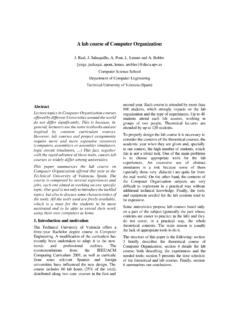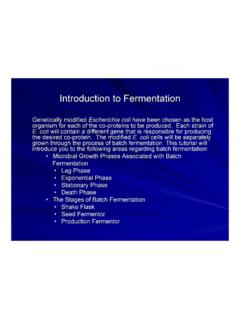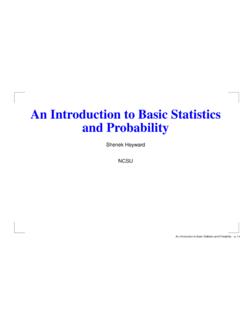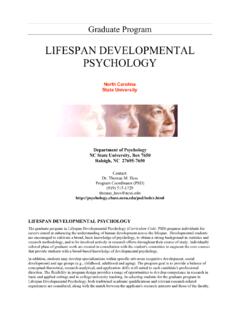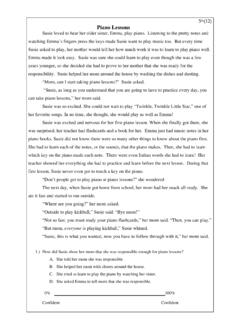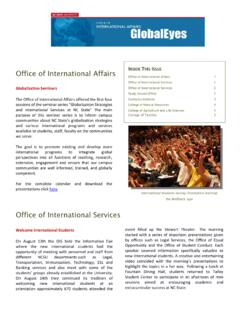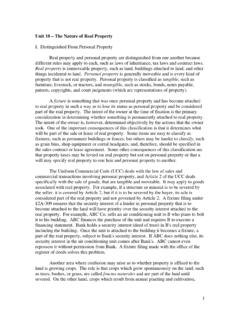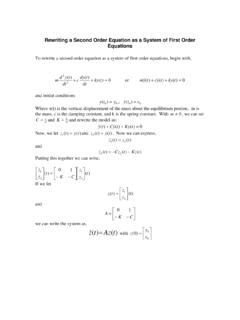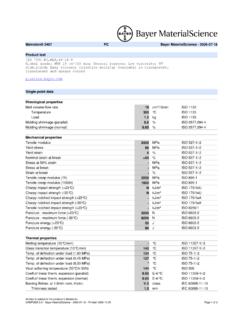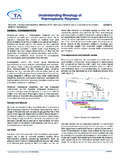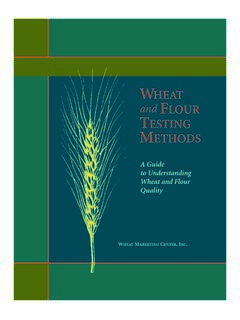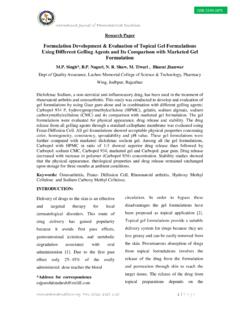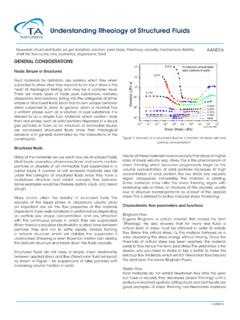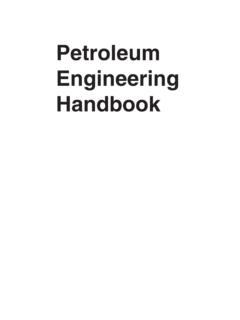Transcription of Fluid Flow - NCSU
1 Fluid FlowOutline Fundamentals and applications of rheology Shear stress and shear rate Viscosity and types of viscometers rheological classification of fluids Apparent viscosity Effect of temperature on viscosity Reynolds number and types of flow Flow in a pipe Volumetric and mass flow rate Friction factor (in straight pipe), friction coefficient (for fittings, expansion, contraction), pressure drop, energy loss Pumping requirements (overcoming friction, potential energy, kinetic energy, pressure energy differences)2 Fundamentals of Rheology Rheology is the science of deformation and flow The forces involved could be tensile, compressive, shear or bulk (uniform external pressure) Food rheology is the material science of food This can involve Fluid or semi-solid foods A rheometer is used to determine rheological properties (how a material flows under different conditions) Viscometers are a sub-set of rheometers3 Applications of Rheology Process engineering calculations Pumping requirements, extrusion, mixing, heat transfer, homogenization, spray coating Determination of ingredient functionality Consistency, stickiness etc.
2 Quality control of ingredients or final product By measurement of viscosity, compressive strength etc. Determination of shelf life By determining changes in texture Correlations to sensory tests Mouthfeel4 Stress and Strain Stress: Force per unit area(Units: N/m2or Pa) Strain: (Change in dimension)/(Original dimension)(Units: None) Strain rate: Rate of change of strain(Units: s-1) Normal stress: [Normal (perpendicular) force] / [Area] Shear stress: [Shear (parallel) force] / [Area] Units: Pa Shear rate: Abbreviation for shear strain rate It is the velocity gradient (du/dx) in many cases Units: s-15 Shear ForcesMax resistanceMin resistance6 Shear Rate Max shear rate for Fluid flow in small gaps (Velocity difference)/(Gap thickness) Max shear rate for brushing/spreading a paste (Velocity of brush)/(Thickness of paste) Max shear rate for Fluid flow in large gaps (Mid-point velocity End-point velocity)/(Half height) (Maximum velocity)/(Height) Max shear rate for pipe flow 4V/ Stress In general, Shear stress = (shear rate) Shear stress = (velocity gradient) In a rotational viscometer, Max shear stress Torque/(2 R2L) For pipe flow, Max shear stress 4V/ R3OR 4 Stress & Shear Rate for Pipe Flow Shear stress Maximum at wall Zero at center of pipe Velocity Zero at wall (under ideal no-slip conditions) Maximum at center of pipe Shear rate Maximum at wall Zero at center of pipe9 Shear Rate for Various ProcessesProcessShear Rate (s-1)
3 Sedimentation10-6to 10-3 Leveling10-2to 10-1 Extrusion100to 103 Pumping100to 103 Chewing/Brushing101to 102 Stirring/Mixing101to 103 Curtain coating102to 103 Rubbing/Spraying103to 105 Lubrication (bearings)103-10710 Viscosity ( ) -- Newtonian Fluids A measure of resistance to flow Ratio of shear stress ( ) to shear rate ( ) SI Units: Pa s cgs units: centipoise (cP); 1 cP = Pa s Viscosity ( ) of water at 20 C = 1 cP Viscosity of water dec. by ~3% for every 1 C inc. in temp. Measurement of viscosity Tube viscometer (Cannon-Fenske) Rotational viscometer (Brookfield, Haake) Empirical technique (Bostwick consistometer) Where is viscosity used?NRe= (Density) (Avg. vel.) (Diameter) / (Viscosity)Reynolds number determines flow type: Behavior for Time-Independent Fluids(Herschel-Bulkley Model for Shear Stress vs. Shear Rate) = Shear stress (Pa) 0= Yield stress (Pa) = Shear rate (s-1)K = Consistency coeff.
4 (Pa sn)n = Flow behavior indexNewtonian 0= 0, n = 1 Then, K = .n < 1n > 1n = 1 Yield Model: Power-law Model: 12 Examples of Types of Fluids(Herschel-Bulkley Model) Newtonian: Water, clear fruit juices, milk, honey, vegetable oil, corn syrup Shear thinning (Pseudoplastic): Applesauce, banana puree, orange juice concentrate, French mustard, dairy cream Dilatant: Some types of honey, 40% raw corn starch solution Bingham plastic: Tomato paste, toothpaste Herschel-Bulkley: Minced fish paste, raisin paste13 Apparent Viscosity: Non-Newtonian Fluids(Power-Law Fluids) For Newtonian fluids, the ratio of shear stress to shear rate is independent of the magnitude of shear rate This ratio of shear stress to shear rate is called viscosity ( ) Eg., The viscosity of water at 20 C is Pa s For power-law fluids (shear thinning, dilatant), the ratio of shear stress to shear rate is dependent on the magnitude of shear rate This ratio of shear stress to shear rate is called the apparent viscosity ( app); app= / = K n/ = K n-1 The magnitude of apparent viscosity MUST be accompanied with the magnitude of shear rate Eg.
5 , The apparent viscosity of Fluid A at 20 C is 20 Pa s at a shear rate of 25 Viscosity (contd.)For pseudoplastic and dilatant fluids, For pseudoplastic fluids, appdecreases with an increase in shear rateFor dilatant fluids, appincreases with an increase in shear rateNote: For pseudoplastic & dilatant fluids, app& do NOT change with timeSingle point apparent viscosity: Human perception of thickness of a Fluid food is correlated to appat 60 (Pseudoplastic Fluid )(Dilatant Fluid )15 Time Dependent Fluids Thixotropic fluids Exhibit a decrease in shear stress (and app) over time at constant shear rate Eg., starch-thickened baby foods, yogurt, condensed milk, mayonnaise, egg white Rheopectic fluids Exhibit an increase in shear stress (and app) over time at constant shear rate Eg., Whipping cream, lubricants, printer s inks Thixotropy and rheopecty may be reversible or irreversibleTimeShear StressShear RateThixotropyConstant shear rateShear StressShear RateThixotropyRheopectyStep inc.
6 In shear rateInc. & dec. in shear rate16 Effect of Temperature on ViscosityArrhenius equation for Newtonian fluids:TemperatureViscosity : Viscosity at temperature, T (Pa s) 1: Viscosity at temperature, T1(Pa s) 2: Viscosity at temperature, T2(Pa s)BA: Arrhenius const. or frequency factor (Pa s)Ea: Activation energy for viscous flow (J/kg mol)R: Universal gas constant (= J/mol K = 8314 J/kg K)T: Temperature (must be in K; C NOT okay)Determining Ea& BA:ln ( ) = ln (BA) + Ea/RTPlot ln ( ) versus 1/TSlope = Ea/R; intercept = ln (BA)Ea= R * SlopeBA= eintercept17 Rotational Viscometer (Newtonian Fluid ) Principle Measure torque [a measure of shear stress ( in Pa] versus rpm [a measure of shear rate ( in s-1].T: Torque (N m)N: Revolutions per second (s-1)L: Spindle length (m)Ri, Ro: Radius of spindle, cup resp. (m)Plot T on y-axis versus N on x-axis. The slope of this graph is 8 2L /[1/Ri2 1/Ro2].))
7 Obtain from Viscometer Principle Measure pressure drop ( P) versus volumetric flow rate (V) across a straight section of tube of length, L and radius, P on y-axis vs. V on x-axisSlope = (8L ) / ( R4)Obtain from , L: m P: PaV: m3/s : Pa Viscometer (contd.) Capillary tube When gravitational force provides the pressure in a (capillary) tube viscometer, P = gL t is the time taken for a certain mass m of the Fluid to traverse distance, L of the tube20 Bostwick ConsistometerCompartment: 5 x 5 x cmInclined trough: Graduated (5 cm x 24 cm)Spring loaded gateHow far does the product travel in 30 s?Good for Quality of Viscometric Data How can information from rotating a spindle in a beaker of Fluid translate to practical situations? First step would be to determine for a Newtonian Fluid or K & n (and appat shear rate of interest) for a non-Newtonian Fluid Then, you can determine pumping power required to pump a Fluid in a pipeline at a given flow rate You can also determine the uniformity of processing based on the velocity profile during pipe flow22 Factors Affecting Type of Flow in a Pipe What factors affect if flow in a pipe is going to be steady/streamlined OR erratic/random?
8 System parameter Diameter of pipe Process parameter Mass flow rate of product Product property ViscosityThe above 3 parameters are grouped into ONE dimensionless (unitless) quantity called Reynolds Number (NRe) and the magnitude of this number can be used to determine if the flow will be steady or Number (for Newtonian Fluids)dh= Hydraulic diameter = 4 (Across-section)/(Wetted perimeter)= Inside diameter of pipe (D) for flow in a pipe= dio doifor flow in an annulus (diois the inside diameter of the outer pipe and doiis the outside diameter of the inner pipe)For flow inside a pipe of diameter, D: : Density of Fluid (kg/m3)u: Average velocity of Fluid (m/s) : Viscosity of Fluid (Pa s).24 Reynolds Number and Types of Flow Laminar flow: NRe< 2,100 Steady, streamlined flow Transitional flow: 2,100 < NRe< 4,000 Neither steady nor completely erratic or random Turbulent flow: NRe> 4,000 Erratic, random flowdh= Hydraulic diameter = 4 (Across-section)/(Wetted perimeter)= Inside diameter of pipe for flow in a pipe= dio doifor flow in an annulus (diois the inside diameter of the outer pipe and doiis the outside diameter of the inner pipe) : Density of Fluid (kg/m3)u: Average velocity of Fluid (m/s) : Viscosity of Fluid (Pa s)25 Significance of Reynolds Number It is the ratio of inertial forces and viscous forces The magnitude gives us an indication of which forces dominate High NRe=> Inertial forces dominate over viscous forces26 Reynolds Number (for Power-Law Fluids) NGRe: Generalized Reynolds number K: Consistency coefficient (Pa sn) n.
9 Flow behavior index : Density of Fluid (kg/m3) u: Average velocity of Fluid (m/s) dh: Hydraulic diameter (m)The critical Reynolds number [NRe(critical)], beyond which flow is no longer laminar, is given by:27 Poiseuille Flow(Pressure Driven Flow in a Cylindrical Pipe) For laminar flow of Newtonian fluids in a circular conduit of radius, R: For laminar flow of power-law (shear thinning or shear thickening) fluids in a circular conduit of radius, R:r: Radial distance from center (m)u: Velocity at radial distance, r (m/s)u: Average velocity (m/s)r: Radial distance from center (m)u: Velocity at radial distance, r (m/s)n: Flow behavior indexu: Average velocity (m/s)This equation translates to a parabolic velocity profile28 Velocity Profiles and their ImplicationNewtonianLaminar(n = 1)DilatantLaminar(n > 1)PseudoplasticLaminar(n < 1)umax> 2 uumax< 2 uumax= 2 uNewtonianTurbulent(n = 1)umax= uExample: Heating of a Fluid food product in an indirect contact heat exchanger with the Fluid food flowing in the inside tube and hot water flowing through the outside streams close to the center of the pipe flow the fastest and also heat up the slowest due to their distance from hot water.
10 Thus, they receive minimal heat streams close to the wall of the pipe flow slowest and also heat up the fastest due to their proximity to hot water. Thus, they receive maximum heat the velocity difference between Fluid streams at the center and wall, greater the quality difference in the food. Thus, flatter the velocity profile, more uniform the and Exit Effects As a Fluid enters a pipe from a reservoir, the velocity profile is flat (plug flow) It then develops to a parabolic profile (for laminar flow of a Newtonian Fluid ) after a certain distance This distance is called the entrance length (Le) A similar effect exists towards the discharge end of the pipe The flow in this region is not representative of flow in the rest (majority) of the system Thus, pressure gauges, flow meters etc are not placed in close proximity to entrances, exits, bends, valves D = NRefor Laminar flowLe/ D = NRe1/6for Turbulent flowD: Pipe diameter30 Flow RatesVolumetric flow rateMass flow rateV: Volumetric flow rate of product (m3/s)m: Mass flow rate of product (kg/s) : Density of Fluid (kg/m3)u: Average velocity of Fluid (m/s)A.
